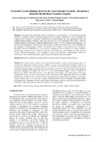Please use this identifier to cite or link to this item:
https://accedacris.ulpgc.es/jspui/handle/10553/823
| Title: | Evolución Geomorfológica de la Isla de Gran Canaria : Isostasia, vulcanismo y disección fluvial (Islas Canarias, España) | Other Titles: | Geomorphologic development of the Gran Canaria Island: Isostasy, Volcanism and fluvial dissection (Canary Islands Spain) | Authors: | Silva Barroso, Pablo Gabriel Pérez Torrado, Francisco José Martín Betancor, Moisés |
UNESCO Clasification: | 250621 Vulcanología | Keywords: | Geomorfología Vulcanismo Canarias Gran Canaria Fluvial erosion, et al |
Issue Date: | 2008 | Publisher: | Sociedad Geológica de España | Project: | PI2002/148 (Gobierno de Canarias) CGL2004-04039/BTE (CICYT) |
Journal: | Geotemas (Madrid) | Conference: | VII Congreso Geológico de España | Abstract: | El análisis del volumen de material vaciado por la erosión fluvial en Gran Canaria permite calcular la respuesta isostática mediante la aplicación de sencillas ecuaciones de relieve geofísico.
El volumen total de material erosionado (223,95 km3) en Gran Canaria tan solo representa el 0,5% del volumen total del edificio volcánico, pero cerca del 26% de su sector emergido (859,77 km3). Aún este pequeño volumen de descarga es capaz de explicar hasta el 83% (+71,1 m) de la elevación máxima (+143 m) de la isla registrada por horizontes de pillow-lavas (ca. 4 Ma) en el Sector NE de la isla. El análisis de las relaciones evolutivas entre erosión y vulcanismo en el contexto de los procesos de disección y elevación diferencial (SW-NE) de la isla aquí se interpretan como un proceso de flexura isostática generado por la masiva isla de Tenerife desde hace 3,5-3,8 Ma. Una retroalimentación entre descarga erosiva, elevación diferencial, efecto orográfico, flexura de la litosfera y underplating, controla la evolución de islas volcánicas de punto caliente durante su etapa de rejuvenecimiento. The analysis of the volume of material wasted by fluvial erosion in Gran Canaria allows toevaluate the subsequent isostatic response (uplift) by means of the application of simple equations ofGeophysical relief. The total removed volume (223.95 km3) in Gran Canaria only represents about 0.5%of the bulk volcanic edifice, but about 26% of its emerged sector (859.77 km3). Even this small amount oferosional unloading can explain the 83% (+71.1 m) of the maximum uplift (+143 m) recorded bypliocene (ca. 4 Ma) pillow-lava horizons in the NE slope of the island. The study of the evolutionaryrelationships between erosion and volcanism within the context of the differential dissection and uplift(SW-NE) are interpreted here as linked to the isostatic flexure generated by the neighbour and massiveTenerife Island since 3.5-3.8 Ma ago. Complex feedback between fluvial unloading, differential uplift,orographic effect, lithospheric flexure, and volcanic underplating, seems to control the geomorphologicaldevelopment of hot-spot volcanic islands during their rejuvenation stage. |
URI: | https://accedacris.ulpgc.es/handle/10553/823 | ISSN: | 1576-5172 | Source: | Geotemas [ISSN 1576-5172], v. 10, p. 727-730. | URL: | http://dialnet.unirioja.es/servlet/articulo?codigo=7769697 |
| Appears in Collections: | Actas de congresos |
Page view(s)
285
checked on Nov 2, 2024
Download(s)
212
checked on Nov 2, 2024
Google ScholarTM
Check
Share
Export metadata
Items in accedaCRIS are protected by copyright, with all rights reserved, unless otherwise indicated.
